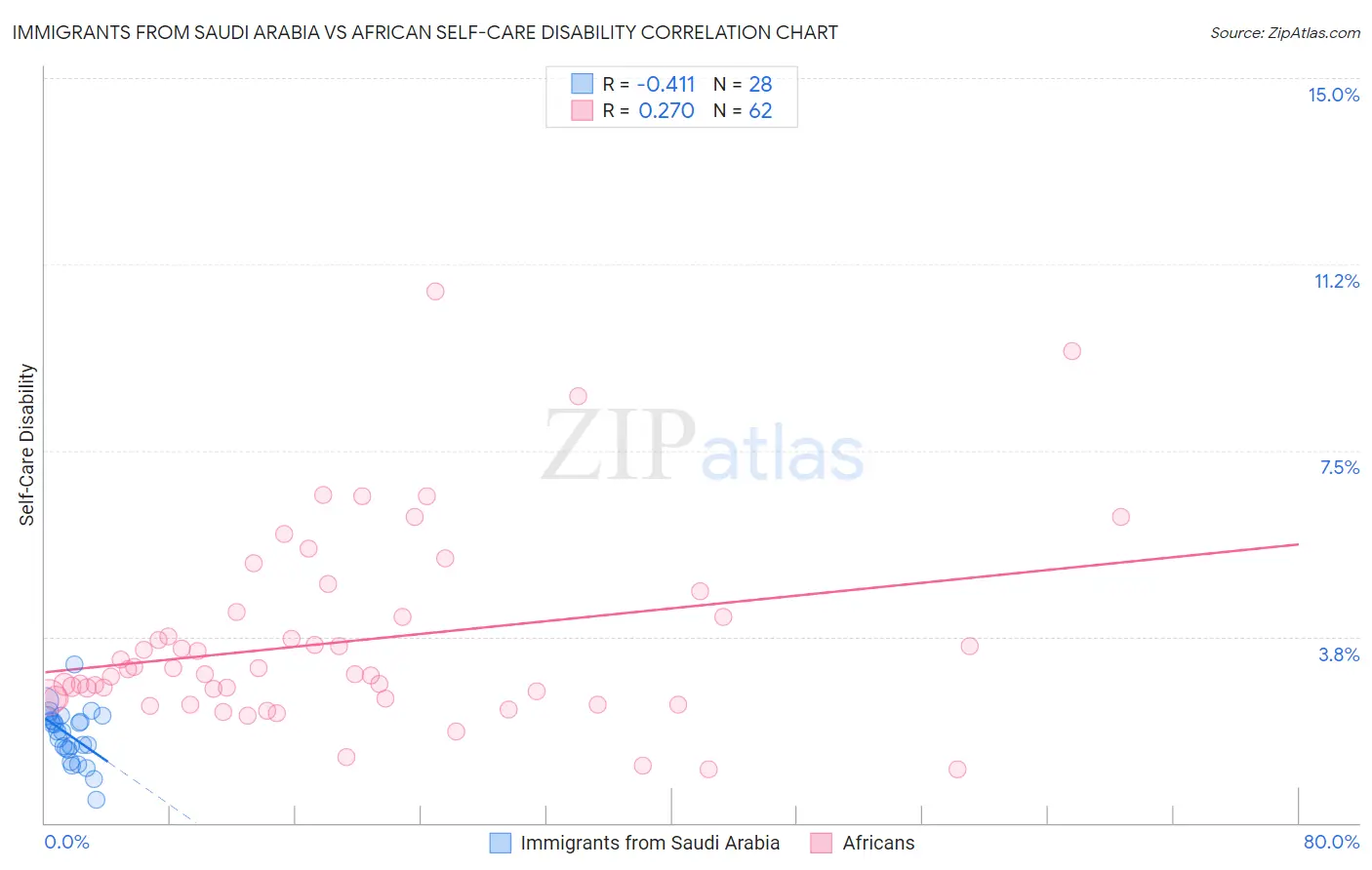Immigrants from Saudi Arabia vs African Self-Care Disability
COMPARE
Immigrants from Saudi Arabia
African
Self-Care Disability
Self-Care Disability Comparison
Immigrants from Saudi Arabia
Africans
2.2%
SELF-CARE DISABILITY
100.0/ 100
METRIC RATING
17th/ 347
METRIC RANK
2.7%
SELF-CARE DISABILITY
0.0/ 100
METRIC RATING
289th/ 347
METRIC RANK
Immigrants from Saudi Arabia vs African Self-Care Disability Correlation Chart
The statistical analysis conducted on geographies consisting of 164,197,287 people shows a moderate negative correlation between the proportion of Immigrants from Saudi Arabia and percentage of population with self-care disability in the United States with a correlation coefficient (R) of -0.411 and weighted average of 2.2%. Similarly, the statistical analysis conducted on geographies consisting of 469,231,301 people shows a weak positive correlation between the proportion of Africans and percentage of population with self-care disability in the United States with a correlation coefficient (R) of 0.270 and weighted average of 2.7%, a difference of 23.5%.

Self-Care Disability Correlation Summary
| Measurement | Immigrants from Saudi Arabia | African |
| Minimum | 0.47% | 1.1% |
| Maximum | 3.2% | 10.7% |
| Range | 2.7% | 9.6% |
| Mean | 1.8% | 3.7% |
| Median | 1.8% | 3.0% |
| Interquartile 25% (IQ1) | 1.5% | 2.5% |
| Interquartile 75% (IQ3) | 2.1% | 4.2% |
| Interquartile Range (IQR) | 0.62% | 1.6% |
| Standard Deviation (Sample) | 0.55% | 1.9% |
| Standard Deviation (Population) | 0.54% | 1.9% |
Similar Demographics by Self-Care Disability
Demographics Similar to Immigrants from Saudi Arabia by Self-Care Disability
In terms of self-care disability, the demographic groups most similar to Immigrants from Saudi Arabia are Immigrants from Kuwait (2.2%, a difference of 0.16%), Immigrants from Taiwan (2.2%, a difference of 0.25%), Okinawan (2.2%, a difference of 0.44%), Luxembourger (2.2%, a difference of 0.45%), and Immigrants from Eritrea (2.2%, a difference of 0.59%).
| Demographics | Rating | Rank | Self-Care Disability |
| Sudanese | 100.0 /100 | #10 | Exceptional 2.2% |
| Immigrants | South Central Asia | 100.0 /100 | #11 | Exceptional 2.2% |
| Immigrants | Ethiopia | 100.0 /100 | #12 | Exceptional 2.2% |
| Ethiopians | 100.0 /100 | #13 | Exceptional 2.2% |
| Luxembourgers | 100.0 /100 | #14 | Exceptional 2.2% |
| Okinawans | 100.0 /100 | #15 | Exceptional 2.2% |
| Immigrants | Kuwait | 100.0 /100 | #16 | Exceptional 2.2% |
| Immigrants | Saudi Arabia | 100.0 /100 | #17 | Exceptional 2.2% |
| Immigrants | Taiwan | 100.0 /100 | #18 | Exceptional 2.2% |
| Immigrants | Eritrea | 100.0 /100 | #19 | Exceptional 2.2% |
| Tongans | 100.0 /100 | #20 | Exceptional 2.2% |
| Bulgarians | 100.0 /100 | #21 | Exceptional 2.2% |
| Immigrants | Venezuela | 100.0 /100 | #22 | Exceptional 2.2% |
| Cambodians | 100.0 /100 | #23 | Exceptional 2.2% |
| Cypriots | 100.0 /100 | #24 | Exceptional 2.2% |
Demographics Similar to Africans by Self-Care Disability
In terms of self-care disability, the demographic groups most similar to Africans are Immigrants from Barbados (2.7%, a difference of 0.10%), Immigrants from Jamaica (2.7%, a difference of 0.14%), Cuban (2.7%, a difference of 0.15%), Guyanese (2.7%, a difference of 0.41%), and French American Indian (2.7%, a difference of 0.47%).
| Demographics | Rating | Rank | Self-Care Disability |
| Apache | 0.0 /100 | #282 | Tragic 2.7% |
| Delaware | 0.0 /100 | #283 | Tragic 2.7% |
| Fijians | 0.0 /100 | #284 | Tragic 2.7% |
| Jamaicans | 0.0 /100 | #285 | Tragic 2.7% |
| French American Indians | 0.0 /100 | #286 | Tragic 2.7% |
| Immigrants | Jamaica | 0.0 /100 | #287 | Tragic 2.7% |
| Immigrants | Barbados | 0.0 /100 | #288 | Tragic 2.7% |
| Africans | 0.0 /100 | #289 | Tragic 2.7% |
| Cubans | 0.0 /100 | #290 | Tragic 2.7% |
| Guyanese | 0.0 /100 | #291 | Tragic 2.7% |
| Central American Indians | 0.0 /100 | #292 | Tragic 2.7% |
| Belizeans | 0.0 /100 | #293 | Tragic 2.7% |
| Blackfeet | 0.0 /100 | #294 | Tragic 2.7% |
| Barbadians | 0.0 /100 | #295 | Tragic 2.7% |
| Immigrants | Portugal | 0.0 /100 | #296 | Tragic 2.8% |